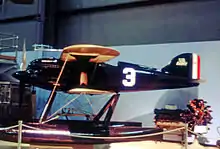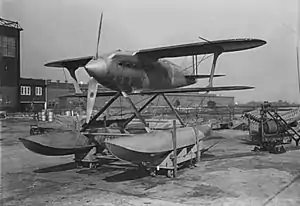Curtiss R3C
The Curtiss R3C was an American racing aircraft built in landplane and floatplane form. It was a single-seat biplane built by the Curtiss Aeroplane and Motor Company.
| Curtiss R3C | |
|---|---|
 | |
| Curtiss R3C-2 | |
| Role | Racing aircraft |
| Manufacturer | Curtiss Aeroplane and Motor Company |
| First flight | 18 September 1925 |
| Introduction | 1925 |
| Primary users | US Navy US Army |
| Number built | 3 |
| Developed from | Curtiss R2C |
The R3C-1[1] was the landplane version and Cyrus Bettis won the Pulitzer Trophy Race in one on 12 October 1925 with a speed of 248.9 mph (406.5 km/h).
The R3C-2 was a twin float seaplane built for the Schneider Trophy race. In 1925, it took place at Chesapeake Bay in Baltimore, Maryland. With 232.57 mph (374.274 km/h), pilot Jimmy Doolittle won the trophy with a Curtiss R3C-2. The other two R3C-2s, piloted by George Cuddihy and Ralph Oftsie, did not reach the finish line. The next day, with the same plane on a straight course, Doolittle reached 245.7 mph (395.4 km/h), a new world record. For the next Schneider Trophy, which took place on 13 November 1926, the R3C-2's engine was further improved, and pilot Christian Franck Schilt took second place with 231.364 mph (372.34 km/h).
Operators

- United States Navy - two examples
- United States Army Air Service - one example
Survivors
The R3C-2 that Jimmy Doolitle piloted to victory in the 1925 Schneider Trophy race is preserved at the National Air and Space Museum's Steven F. Udvar-Hazy Centre, at Washington Dulles Airport, Virginia. It still wears its '3' 1925 racing number.
Specifications (R3C-2)


Data from Curtiss Aircraft 1907–1947[2]
General characteristics
- Crew: 1
- Length: 22 ft 0 in (6.71 m)
- Wingspan: 22 ft 0 in (6.71 m)
- Height: 10 ft 4 in (3.15 m)
- Wing area: 144 sq ft (13.4 m2)
- Airfoil: Curtiss C-80[3]
- Empty weight: 2,135 lb (968 kg)
- Gross weight: 2,738 lb (1,242 kg)
- Powerplant: 1 × Curtiss V-1400 V-12 water-cooled piston engine, 565 hp (421 kW)
- Propellers: 2-bladed fixed-pitch propeller
Performance
- Maximum speed: 245 mph (394 km/h, 213 kn)
- Range: 290 mi (470 km, 250 nmi) at full throttle
See also
In culture
- A Curtiss R3C appears in Hayao Miyazaki's Porco Rosso animated movie featuring a romanticized interwar aviation. The Curtiss R3C is flown by a pilot himself named Curtiss. The dialogues also reference the 1925 Schneider Trophy.
References
- Also given the "paper" designation F3C as fighters in the US Navy designation system: Swanborough and Bowers 1976, p.127.
- Bowers, Peter M. (1979). Curtiss aircraft, 1907-1947. London: Putnam. pp. 233–239. ISBN 0370100298.
- Lednicer, David. "The Incomplete Guide to Airfoil Usage". m-selig.ae.illinois.edu. Retrieved 16 April 2019.
- Angelucci, Enzo. World Encyclopedia of Civil Aircraft. London:Willow Books, 1984. ISBN 0-00-218148-7.
- Bowers, Peter M. Curtiss Aircraft 1907–1947. London:Putnam, 1979. ISBN 0-370-10029-8.
- Swanborough, Gordon and Bowers, Peter M. United States Navy Aircraft since 1911. London:Putnam, 1976. ISBN 0-370-10054-9.
- The Golden Age of Aviation – Curtiss R3C-2
- Pulitzer Trophy web site
- Schneider Trophy 1925 web site (french)
- German edition “Flugzeuge”, Enzo Angelucci, 1974 ISBN 3-8068-4024-5
- results of the Schneider Trophy from the Society of Air Racing Historians
External links
| Wikimedia Commons has media related to Curtiss R3C. |